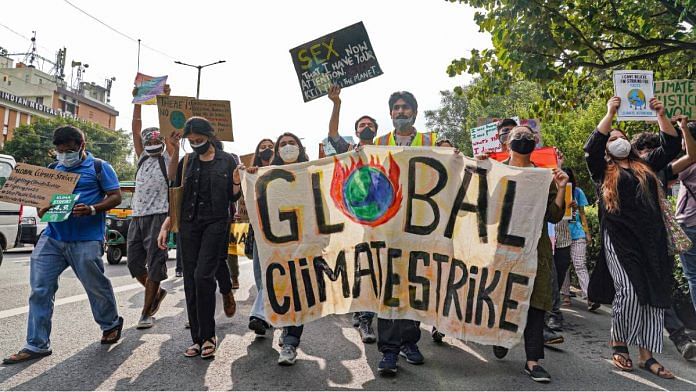New Delhi: On 27 September, India officially ratified the Kigali Amendment of the Montreal Protocol, joining 125 other countries in the fight to phase out hydrofluorocarbons (HFCs) — harmful greenhouse gases used in refrigeration and air-conditioning that are known to accelerate global warming.
This key amendment is part of the larger ‘Montreal Protocol on Substances that Deplete the Ozone Layer’ framework, or the Montreal Protocol, which is a global pact seeking to regulate the production and consumption of nearly 100 manmade ozone-depleting substances. All United Nations (UN) members are parties to the pact.
Ozone-depleting substances are considered harmful for the Earth’s ozone layer — a thin layer in the stratosphere containing ozone molecules, which absorb cancer-causing ultraviolet rays from the Sun.
HFCs don’t deplete the ozone layer, but they have a high global warming potential (GWP) of 12 to 14,000. Global warming potential is a value assigned to represent the amount of heat trapped by it, relative to the amount of heat trapped by a similar mass of carbon dioxide. The GWP of carbon dioxide, the primary greenhouse gas due to human emissions, is 1.
According to the United Nations Environment Programme (UNEP), overall HFC emissions are growing at a rate of 8 per cent per year and the annual emissions are projected to rise to 7-19 per cent of global CO2 emissions by 2050.
Also read: Editorial by 220 journals, including Lancet and BMJ, urges emergency action on climate change
The Vienna Convention — where it all began
The Vienna Convention for the Protection of the Ozone Layer was held the same year a major, worrying discovery about a ‘hole’ in the ozone layer over the Antarctic was discovered, in 1985.
Ozone is a molecule made up of three oxygen atoms and can be destroyed when it comes into contact with bromine or chlorine. Some of the compounds that release chlorine include chlorofluorocarbons (CFCs) and hydrochlorofluorocarbons (HCFCs) — two potent ozone-depleting substances that were commonly used in refrigerators, air conditioners, foaming and cleaning agents, car dashboards, and the soles of shoes, among hundreds of other things.
The Convention was the first international agreement dedicated to protecting the ozone layer. All countries were required to cooperate in research and exchange information about the ozone layer, and adopt “appropriate measures” to protect it.
But the agreement made no enforceable rules, neither did it enact any control measures. According to UN archives, “During the Vienna Convention negotiations, countries discussed a possible protocol that would provide specific targets for certain chemicals, but no consensus was reached.”
A working group under the UNEP began negotiations on a protocol, out of which the Montreal Protocol was formed in 1987.
Also read: Taking the lead on climate action could be worth $11 trillion to India
The Montreal Protocol
Unlike the Vienna Convention, the Montreal Protocol lays down legally binding and measurable agreements with specific timelines for high-income and low-income countries to follow. It mandated the complete phase-out of CFCs and HCFCs, for example, and made provisions for control measures, monitoring of trade, and annual reporting of data on ozone-depleting substances.
Thirty years after it first came into effect, the Montreal Protocol succeeded in phasing out 99 per cent of harmful ozone-depleting substances, and the hole in the ozone layer is likely to go back to pre-1980 levels by 2070. According to the UN, without the Protocol, the hole over the Antarctic would have been about 40 per cent larger in size by 2013.
It has also led to the prevention of an estimated 2 million cases of skin cancer each year by 2030.
The Meeting of the Parties — the governance body of the Montreal Protocol — happens every year, and the Protocol continues to be adjusted and amended to meet its goals.
The Kigali Amendment, signed in 2016, is the latest.
Also read: Rich nations aren’t pooling in the big bucks to help poorer nations tackle climate change
The Kigali Amendment
The Montreal Protocol was never meant to be a tool to combat climate change, but it has become one with the Kigali Amendment, which was signed in October 2016 at the Rwandan capital.
The phase-down of HFCs under the amendment is expected to prevent the emission of up to 105 million tonnes of carbon dioxide by 2100, which in turn will help avoid an up to 0.5 degree rise in global temperatures above pre-industrial levels.
Like the Montreal Protocol, targets in the Kigali Agreement have been staggered for high- and low-income countries. Countries like the US must meet this target by 2036, while India has until 2047 and China until 2045. India was one of the last, major countries to officially ratify the amendment.
The Kigali Amendment’s contribution to curbing global warming is especially significant in light of another crucial climate treaty, the Paris Agreement.
Signed in 2015, the Paris Agreement is a legally binding policy that requires countries to cut emissions of greenhouse gases in order to slow global warming. The agreement aims to keep global temperatures “well below” a set threshold — 2°C above pre-industrial levels — to prevent extreme weather events and climate change.
(Edited by Poulomi Banerjee)
Also read: India, US will work together to advance clean energy goals, says climate envoy John Kerry



